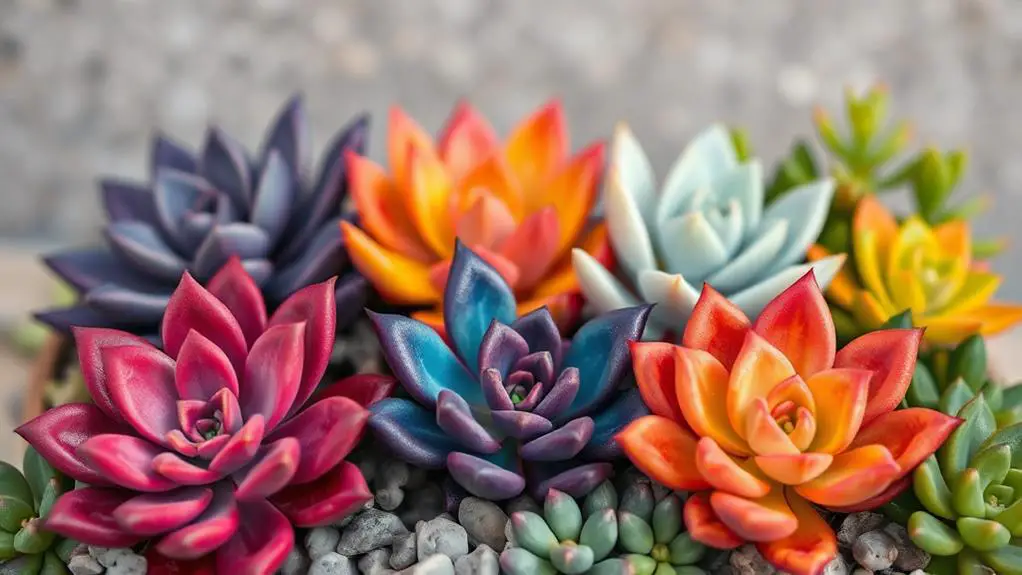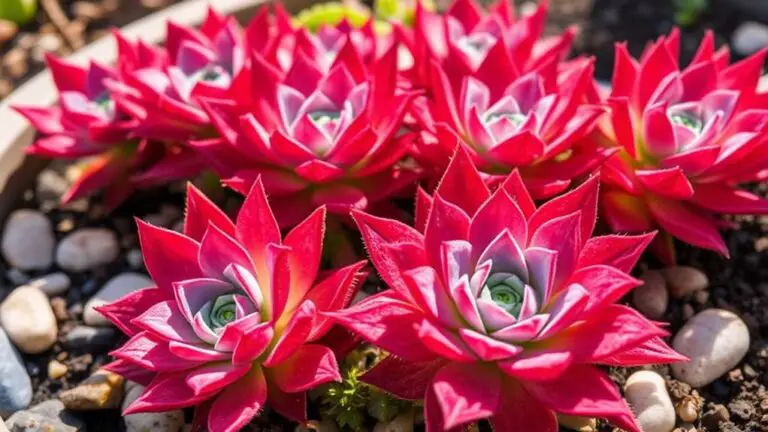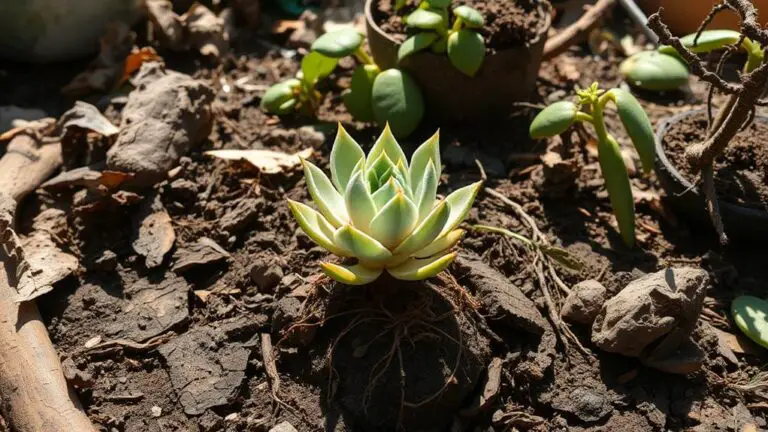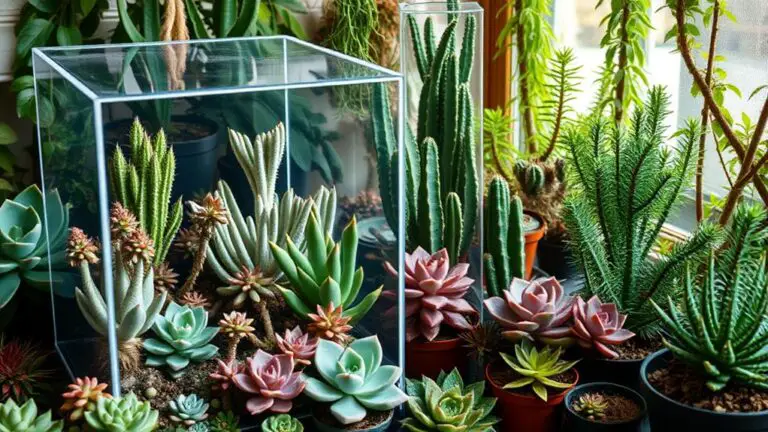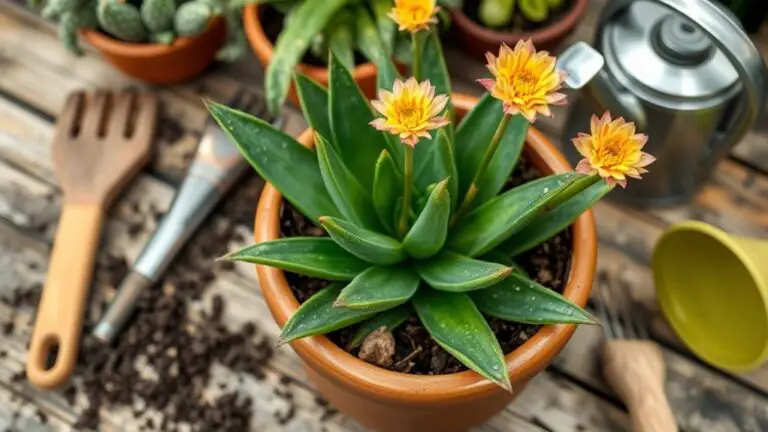Painted Succulents: Trendy or Harmful?
You've probably seen painted succulents making the rounds on social media with their eye-catching, vibrant hues. They're undeniably trendy, but have you ever wondered about the impact of these dyes on the plants themselves? Some argue that these colorful modifications inhibit photosynthesis and nutrient absorption, potentially harming the plant in the long run. Others say it's just a harmless way to enjoy nature's beauty in a new form. So, what's the real story behind these painted succulents, and is their popularity worth the potential risk to plant health?
Definition and Appeal

Painted succulents, which are succulents dyed with vibrant, non-toxic, and food-safe dyes, have taken the plant market by storm. Their striking appearance has made them a popular choice for anyone looking to add a splash of color to their decor.
When you see a painted succulent, it's hard not to be drawn to its bold and lively hues. These colors can range from bright blues and purples to vivid pinks and oranges, turning an ordinary plant into a stunning showpiece.
However, it's important to understand what makes painted succulents so unique. The dye only affects the surface of the plant, meaning the original colors of new growth won't match the painted hues.
Over time, as the succulent grows, the vibrant colors will gradually fade. This process usually takes several months to a couple of years. So, while painted succulents can be a temporary highlight in your home or garden, they won't retain their striking appearance forever.
Knowing this, you can better appreciate the beauty and temporary nature of painted succulents. They're a fantastic way to enjoy a burst of color, even if it's just for a while.
Photosynthesis Inhibition

When you paint succulents, the thick layers of dye block light absorption, which is essential for photosynthesis and energy production.
This means your plant can't make the food it needs to grow and stay healthy. As a result, the paint can suffocate the plant, increasing the risk of early death and making it hard for the succulent to recover.
Blocking Light Absorption
Layers of dye on succulents can severely inhibit their ability to perform photosynthesis by blocking essential light absorption. When you paint your succulents, you might think the bright colors make them more attractive, but this comes at a significant cost.
The paint layers act like a shield, preventing the sunlight from reaching the plant's cells, which is vital for photosynthesis. Without adequate light, your succulent can't produce the energy it needs to grow and stay healthy.
Blocking light absorption doesn't just stop photosynthesis; it can also suffocate the plant. The thick paint limits the plant's ability to absorb carbon dioxide, another key ingredient for photosynthesis. Without carbon dioxide, the plant's growth slows down, and it becomes weaker.
Consider these points:
- Light Absorption: Paint blocks essential sunlight, hindering photosynthesis.
- Carbon Dioxide Absorption: Thick paint layers can suffocate the plant.
- Plant Health Decline: Painted succulents often face an accelerated decline.
Horticultural expert Tiernach McDermott notes that painted succulents may experience quicker death due to these issues. New growth won't match the painted sections, further stressing the plant.
Recovery, if it happens, can take years, and many succulents never fully bounce back.
Hindering Energy Production
Inhibiting energy production in succulents through photosynthesis inhibition is a vital issue. When you paint succulents, the dye layers often block the light they need for photosynthesis. This process is essential for their survival because it allows them to produce energy.
Without enough light absorption, your succulents can't generate the energy they need, leading to weakened health and eventual decline. These bright colors might look appealing, but they're hindering energy production. The paint prevents the plant from absorbing essential light, which is necessary for photosynthesis.
When this happens, your succulents can't make the food they need to grow and thrive. Tiernach McDermott and other experts warn that this can considerably increase the risk of early death in painted succulents.
Additionally, thick paint layers can stop succulents from absorbing enough carbon dioxide, another vital component for photosynthesis. When your plants can't perform photosynthesis effectively, their long-term health is compromised.
They become more vulnerable to diseases and other problems, making it difficult for them to survive.
Risk of Suffocation
Have you ever wondered why painted succulents often struggle to survive? The bright colors may look fun, but the thick layers of dye can actually block vital light. This light is important for photosynthesis, the process plants use to make energy. Without it, your succulent can't produce the energy it needs to grow and stay healthy.
When you cover a succulent in paint, you're practically suffocating it. Experts like Tiernach McDermott warn that the paint can make it impossible for the plant to recover. Succulents need their leaves to be free of paint to properly photosynthesize.
The longevity of the paint only makes things worse, as painted succulents can't replace their old leaves with new, unpainted ones quickly enough.
Additionally, the paint can block the plant's ability to absorb carbon dioxide, which is another key component of photosynthesis. This means your painted succulent isn't just struggling for light, but also for air.
Here are some key points to remember:
- Paint blocks light, stopping photosynthesis.
- Succulents can't produce energy, leading to early death.
- Recovery from paint damage is often impossible.
Understanding these risks can help you make better choices for your plants.
Dye Chemical Composition

When it comes to painted succulents, understanding the chemical composition of the dyes used is essential. The dyes often contain chemicals like Sodium Benzoate and Citric Acid. These aren't just random ingredients; they can actually harm your plant.
Sodium Benzoate, commonly found in food preservatives, isn't meant for plants. It can interfere with the plant's ability to absorb nutrients and water. Citric Acid, while natural, can alter the pH balance of the plant's skin, making it harder for the succulent to thrive.
The dye layers also pose another problem: they block sunlight. Succulents need light for photosynthesis, a process that allows them to make their own food. With a thick layer of dye, your succulent can't get the light it needs to live.
Worse, the paint can also prevent the plant from absorbing carbon dioxide, another key element in photosynthesis.
Experts aren't sure about the long-term effects of these dyes, but they do know that thick paint layers can lead to early plant death. Instead of painted succulents, consider artificial ones. They look great and won't harm any living plants.
This way, you can enjoy vibrant colors without the risks.
Impact on Plant Health
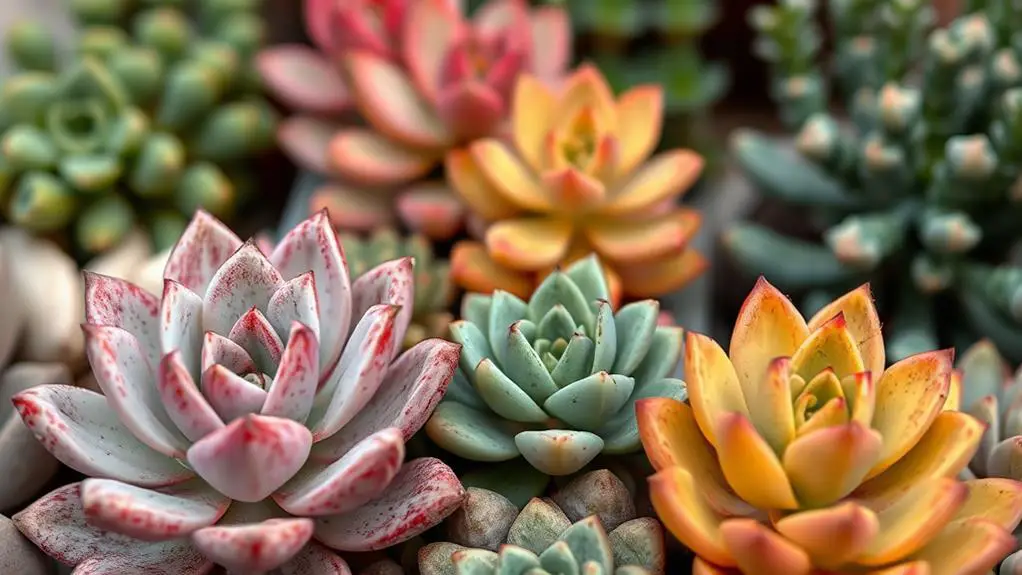
Understanding the chemical composition of the dyes sets the stage for grasping the broader impact on plant health. Painted succulents, though visually appealing, can suffer considerably from the dyes used to coat them. These dyes often contain chemicals like Sodium Benzoate and Citric Acid, which can be harmful to the plants.
When you cover succulents with paint, you're fundamentally blocking their ability to absorb sunlight. This light is vital for photosynthesis, the process plants use to convert light into energy. Without it, your succulent can't produce the energy it needs to grow and thrive.
This can lead to:
- Energy production failure: Without photosynthesis, succulents can't generate the energy they need.
- Increased risk of early death: The lack of important light absorption can cause the plant to die prematurely.
- Long-term damage: Even if the paint wears off, the underlying plant may have suffered lasting harm.
Additionally, the paint can lead to suffocation, as plants need to "breathe" through their leaves.
The compromised health of painted succulents means they often require extra care. So, while painted succulents might look trendy, the impact on their health can be quite severe.
Proper Care Needs
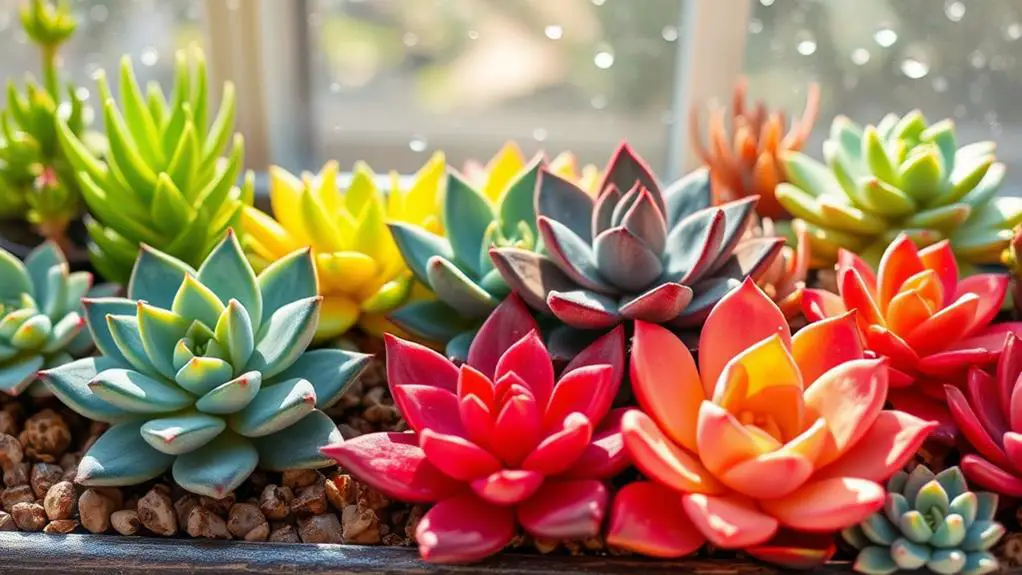
When caring for painted succulents, you need to pay special attention to their light and watering needs.
Make sure they get plenty of bright light to help with the limited photosynthesis due to the paint.
Only water them when the soil feels dry, as too much water can cause root rot.
Light Requirements
To guarantee your painted succulents thrive, it's essential to provide them with ample light. Succulents love sunlight and need at least six hours of direct sunlight each day. Place them near a bright window where they can soak up the rays.
If you don't have a sunny spot, consider using a grow light to meet their light requirements.
Succulents don't do well in low-light conditions. If they don't get enough light, they'll stretch towards the light source and become weak and leggy. This process, called etiolation, can make your succulents look unhealthy and less appealing.
Regularly check their light exposure to confirm they're getting what they need.
Here are some tips to help your succulents thrive:
- Sunny Spots: Place your succulents in the sunniest window you have, preferably one that gets direct sunlight.
- Rotate Plants: Turn your succulents occasionally to make sure all sides get even light exposure.
- Monitor Growth: Watch for signs of stretching, which means they need more light.
Watering Guidelines
Proper watering is essential to keeping your painted succulents healthy and vibrant. To start, it's important to only water your succulents when the soil is dry to the touch. This means letting about 1-2 inches of soil dry out between watering sessions. The exact timing can vary based on the season and humidity.
During the growing season, which is spring and summer, you might need to water them every 1-2 weeks. However, in fall and winter, they may only need water once a month.
Make sure your pots have drainage holes. This prevents water from pooling at the bottom, which can cause root rot and other issues. Always monitor your plants for signs of overwatering. If you notice mushy leaves or yellowing, it means you're giving them too much moisture.
Adjust your watering frequency based on your environment. Succulents in bright, sunny spots will likely need more frequent watering compared to those in shadier areas.
Soil and Fertilization
Ensuring your painted succulents thrive often starts with the right soil and fertilization practices. The soil you choose is essential. Succulents need well-draining soil to prevent water retention and root rot. A mix that includes sand, perlite, or pumice works best. This allows water to drain quickly, keeping the roots healthy.
Watering your succulents should only happen when the soil is completely dry. Overwatering can cause significant health issues, so pay close attention to the soil's moisture. During different seasons, this drying time can vary, so adjust your watering schedule accordingly.
Fertilization is minimal for succulents. They usually only need it during their growing season. Use a diluted, balanced fertilizer every few weeks to give them a boost. This helps them grow strong and vibrant but don't overdo it.
Repotting might be necessary as your succulents grow. Choose a pot with adequate drainage and slightly larger than the current one. Regularly monitor soil moisture and understand the specific needs of your succulent varieties.
- Well-draining soil mix: sand, perlite, pumice
- Water only when soil is dry
- Diluted, balanced fertilizer during growing season
Common Misconceptions

Many people believe that painted succulents are easy-to-care-for decorations, but this couldn't be further from the truth. You might think these colorful plants are perfect for low-light spots, but succulents generally need full sun or very bright light to thrive. The paint on these plants can block sunlight, making it even harder for them to get the light they need.
Another common misconception is that the vibrant colors of painted succulents are permanent. In reality, the paint will wear off as the plant grows, often leaving you disappointed. It's also important to know that succulents aren't naturally colorful. The bright hues are added artificially, and some people even mistake glued-on flowers for real blooms.
You may believe all succulents are low-maintenance, but each type has specific needs. Ignoring these can lead to poor plant health. Painted succulents require extra care to combat the negative effects of dye on their health.
Ethical Concerns

When you see painted succulents, it's easy to be drawn to their bright colors, but there are important ethical concerns to contemplate.
Spray-painting these plants can harm them by blocking sunlight, stopping photosynthesis, and eventually leading to their death.
Plus, misleading marketing often tricks people into thinking these plants are easy to care for, when in reality, they need a lot more attention to stay healthy.
Plant Welfare Issues
The practice of spray-painting succulents raises significant ethical concerns, primarily because it disregards the well-being of the plants. When you spray-paint a succulent, it's not just about changing its color. You're actually blocking essential processes like photosynthesis, which is how the plant makes its food. This can seriously harm the succulent and even lead to its death.
Respecting plant welfare issues means considering the health and natural growth of the plant. Painted succulents are often marketed as decorative items, but this overlooks the ethical implications of altering a living organism's appearance. Many people feel strongly against what they call "succulent abuse" because it causes unnecessary harm.
To help you understand better, here are some key points:
- Blocking Photosynthesis: Paint prevents succulents from absorbing sunlight, which they need to survive.
- Consumer Misunderstanding: Many buyers don't realize the care needs of painted succulents, leading to neglect.
- Lack of Protection: There's no organization like the SPCP (Society for the Prevention of Cruelty to Plants) to guarantee plant welfare.
Misleading Marketing Practices
Despite their vibrant allure, painted succulents are often marketed in ways that mislead consumers. Retailers use enticing names like "Kosmik Kaktus," which might make you think you're buying a unique plant variety. In reality, these plants are simply painted with non-toxic, food-safe dyes. This can be confusing and cause you to believe you're getting something special when you're not.
Another common issue is misidentification. For example, haworthia plants are frequently mislabeled as cacti. This makes it hard to know how to care for them properly. Succulents and cacti have different needs, so getting the wrong information can harm your plant.
| Misleading Aspect | Impact on Consumers |
|---|---|
| Enticing Names (e.g., "Kosmik Kaktus") | Believing they are unique plant varieties |
| Misidentification (e.g., haworthia as cacti) | Confusion about care requirements |
| Lack of Transparency | Unawareness of potential plant harm |
| Exploiting Consumer Trends | Promoting as decorative items without proper info |
These misleading marketing practices exploit current trends without giving you the full picture. Retailers often promote painted succulents as simple decorative items without explaining the potential harm to the plants. Always research your plants and verify you know what you're really buying.
Consumer Reactions

Expressing strong negative sentiments, many consumers equate painted succulents to plant abuse, likening the practice to other forms of mistreatment, such as painted turtles.
You might've noticed this concern popping up in online communities where people share their frustrations and call for an end to what they see as "succulent abuse." This shared disdain reflects a growing awareness and concern for plant welfare.
Consumers like you're increasingly vocal about their preference for more natural options. Some even favor artificial plants over painted succulents, showing a clear shift towards non-living alternatives that don't compromise plant health.
This trend is accompanied by humorous comments from the community, like suggesting googly eyes as a fun, non-harmful way to decorate plants.
If you're looking to join the conversation or just want some practical advice, consider these points:
- Engage in online forums: Share your thoughts and learn from others who care about plant welfare.
- Support ethical retailers: Choose shops that offer natural, unpainted succulents.
- Educate your friends: Spread the word about the downsides of painted succulents.
Responsible Alternatives

Consider shifting your focus to responsible alternatives that maintain the beauty of your home without compromising plant health. Instead of painted succulents, try naturally colorful varieties like moonstone or kalanchoe. These plants offer vibrant aesthetics without the drawbacks of artificial dyes. If you're looking for low-maintenance options, artificial plants can provide a similar decorative effect without harming living organisms.
Educating yourself on proper succulent care can lead to healthier plants. There are many resources and subscription services available to help you choose the right species and care practices. Supporting local growers who prioritize plant health and ethical practices also contributes to a more sustainable and responsible plant industry.
Engaging in DIY projects, such as using water-based paints on artificial plants, allows for creativity while avoiding the harmful effects associated with painting living succulents.
| Responsible Alternative | Benefit |
|---|---|
| Naturally colorful succulents | Vibrant aesthetics without harm |
| Artificial plants | Low-maintenance, no plant damage |
| Supporting local ethical growers | Sustainable and healthy plant industry |
Community Awareness
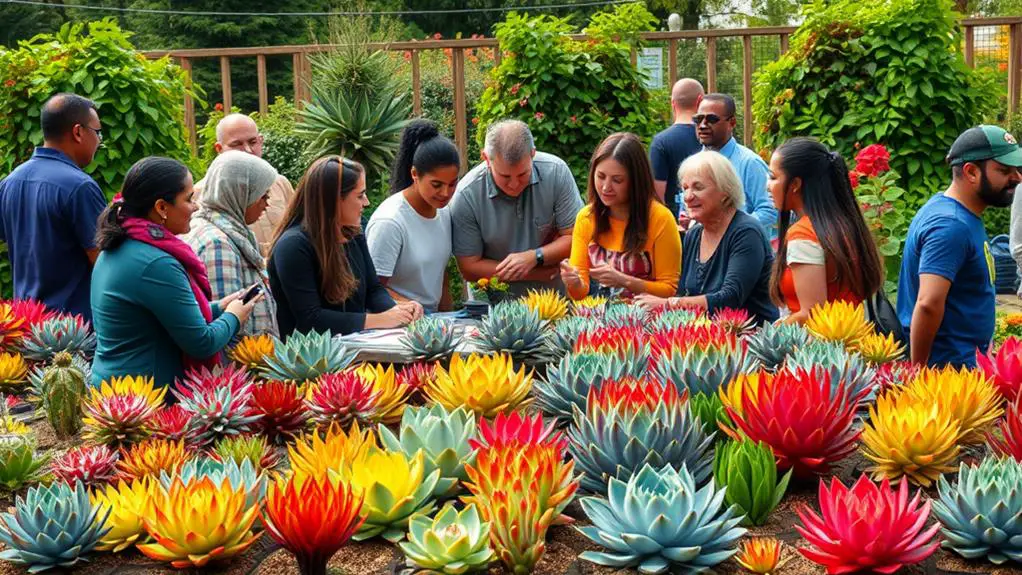
Amid growing concerns over plant welfare, community awareness around the issue of painted succulents has surged. Many people in the gardening community have voiced strong negative opinions about painted succulents. They compare this practice to other forms of plant abuse and are advocating for campaigns against what they call "succulent abuse."
Online discussions are brimming with disdain for painted plants, and there's a push for grassroots efforts to raise awareness about the harmful effects these practices have on plants.
People are sharing personal experiences and frustrations, often using humor to cope with their concerns about plant welfare and misleading marketing practices. These discussions aren't just complaints; they're filled with practical advice and alternative suggestions.
Many consumers now prefer artificial plants over painted succulents. They see artificial plants as a more ethical and sustainable choice that doesn't involve the risks associated with painting live plants.
Here are some key takeaways to help you stay informed and make better choices:
- Advocate for "succulent abuse" awareness campaigns.
- Join online forums to share and gather information.
- Consider artificial plants as an ethical alternative.
Frequently Asked Questions
Why Do Stores Paint Succulents?
You see stores painting succulents to boost their visual appeal, making them more attractive for impulse buyers. They use vibrant colors and catchy names, masking imperfections and meeting the demand for decorative plants, despite potential health issues.
Why Are Succulents Trendy?
Succulents are trendy because they're low-maintenance, visually appealing, and fit perfectly into busy lifestyles. Their vibrant colors and unique shapes make them ideal for stylish home decor, and social media amplifies their appeal with beautiful, shareable images.
Are Painted Echeveria Toxic?
Painted Echeveria aren't toxic to humans, but the dyes can harm the plant. Even non-toxic, food-safe dyes can block photosynthesis, making it hard for the plant to thrive. So, they're not great for long-term plant health.
What Is the Best Color for Succulents?
You should choose succulents in their natural colors. Blues, greens, reds, and pinks are best. These colors change seasonally, reflecting the plant's health. Avoid painted succulents to guarantee they thrive and maintain their beauty naturally.
Conclusion
You love your succulents, and you want the best for them. Painted succulents might look cool, but they can hurt your plants. Instead, go for naturally colorful succulents or even artificial ones. When you choose wisely, your plants will thrive, and you'll enjoy a healthy, happy garden. Remember, understanding their needs and making thoughtful choices shows you're a responsible gardener. Keep learning and growing, and your plants will thank you!

